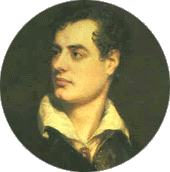Introduction to Literature, Spring 1999
Ray's
Syllabus
Kate's
Syllabus
"The Big Six"
Younger Romantics:
John Keats
(1795-1821)
Percy Bysshe Shelley
(1792-1822)
George Gordon,
Lord Byron
(1788-1824)
Romanticism:
|
British Romantic Poetry
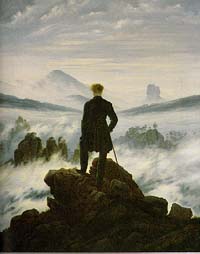
Casper David Friedrich. Wanderer
above the Mist. 1817-1818.
From Arts and Ideas.
William Fleming, 9th ed: p. 532 |
The First Generation:
W. Blake
W. Wordsworth
S.T. Coleridge
U.S. Romantic Poets
Walt Whitman
Emily Dickensen
Romantic Novelist
Emily Bronte |

John Keats (1795-1821)
"Ode on a Grecian Urn"
Greek Pottery from Art of the Western World Michael
Wood; 11. A form of art Greek artists
excelled in. On the urns they depicted mythological scenes as well
as scenes from daily life.
"The Lady of Shalott"--
the
poem and its illustrations |
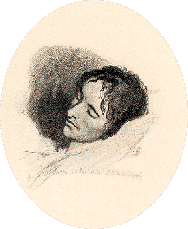
(Portrait of John Keats in Rome, shortly before his
death from tuberculosis in February 1821, by his friend Joseph Severn.)
From Portico
- The British Library's Online information Server
|
"Ode on a Grecian Urn"
E-Text
Questions for Group Discussion and Journal
| The poem can be divided into three parts: in the 1st
stanza the speaker addresses the urn and then asks it questions; in the
2nd to 4th stanzas, the speaker looks at the urn's designs and then imagine
stories, and then in the 5th, the speaker again talks to the urn.
1. The first stanza is difficult because it is filled
with metaphors for the urn and then unanswered questions. The poem
might interest you more if you glimpse through this part and move right
into the middle part (2nd to 4th stanzas). |
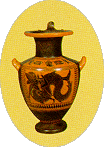
|
Stanza 2: one side of the urn shows a piper playing a pipe
beneath the trees, and then a bold lover chasing his girl. How is this
picture on the urn different from a real life story?
Stanza 3: This difference is what leads to the exclamations
in stanza 3. What is the effect of the repetition of the words "happy"
and "for ever"? If the speaker praises the "happiness" of the permanent
music, love and youth on the urn, why, then, does he switch immediately
to "breathing human passion" and its pains?
Stanza 4: From the questions asked here, obviously this
side of the urn shows neither the altar (the destination) nor the little
town (the starting point)--but the procession on their way to the alter.
What is the significance? Also, why does the speaker addresses the little
town which is not shown on the urn?
Compare stanza 4 with the previous two. What aspect of the urn
do they all show, but treat differently?
 The poem as a whole
The poem as a whole
2. With the stories described on the urn in mind, we can then
try to understand the metaphors and names for the urn in the 1st and last
stanzas. Is there, however, a difference between metaphors in the first
stanza ("bride," "child," "historian") and the names in the last ("attic
shape," "fair attitude" "cold Pastoral")? If so, why?
3. The last two lines may sound like a cliche and then a repeated praise
of the urn. But can they also be read ironically? (Why does the urn
only
know, and only need to know, "Beauty is truth, and truth beauty)?
Keep in mind the contrast between the human world and the worlds shown
on the urn.
4. The poem is basically an apostrophe to an inanimate object.
How does this rhetorical device function in the poem? Does the poet
apostrophize the urn just to praise it? What does he get to understand?
The urn, and/or human beings' difference from it?
5. Re-consider the development of the poem in terms of the poet's attitudes.
What stance, or attitude, does he take in each stanza? Can we say
that the poet "enter" the urn and then leave it (or going through an empathic
process)?
John
Keats: Relevant Links
 Overviews
and Biographies
Overviews
and Biographies
 Keats
poetry and "Ode on a Grecian Urn"
Keats
poetry and "Ode on a Grecian Urn"
-
Brief
Introduction to Keats' Poetry --by
Karen McBurney, undergraduate student at The University of Texas at Austin,
who has a
homepage on her collection/analysis of works by British authors which
contain Spiritual Unrest. The anthology includes selections from
Sir Gawain and the Green Knight, John Donne's "The Canonization," Jonathan
Swift's Gulliver's Travels, John Keats' "Ode
on Melancholy," and T. S. Eliot's The Waste Land.
-
ODE
ON THE GRECIAN URN Student essay about the poem (part of a group project!)
-
Summary
on the poem from
Literatures, Arts and Medicine and Art.
 For Further Studies:
back
For Further Studies:
back
|
Percy Bysshe Shelley (1792-1822)
"Ozymandias" (readingvideo
clip)
|
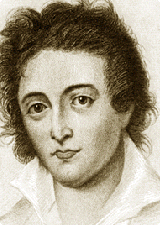
|
"Ozymandias"
E-Text
(with a picture & interpretation)
Questions for Group Discussion and Journal
1. logical structure
| *Ozymandias, or Ramese II, was pharaoh of Egypt in
the thirteenth century B.C.
1. The poem, as an Italian sonnet, can be divided into two parts:
the first eight lines (octave) and the next six lines (sestet). If the
octave part describes the fragments of a sculpture the traveler sees on
an ancient ruin, the sestet goes further to record the words on the pedestal
and then describe the surrounding emptiness. How are the words on the pedestal
in contrast to both the octave and the last three lines (triplet) of the
poem? In other words, what does Ozymandias want to achieve, as opposed
to what is left behind him? |
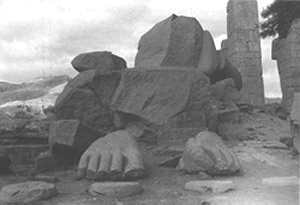
The feet of the colossus of Rameses II on which Shelley's poem
Ozymandias
is based.
From Art, Space and the City p. 68.
|
2. Irony
From the last question, we can see the most obvious kind of opposition
(between what Ozymandias said and what is left behind him). This
opposition has the effect of dramatic irony. What other sets of oppositions
or conflicts can we see in the poem? Are they ironic?
3. Structure of narration
The poem contains a story (told by Ozymandias) within a story (told
by the traveler) within a story (told by) the speaker of the poem). In
the core of this multiple story, the Ozymandias we know is only a sculpture
and the words on it. What does this, as well as the narrative structure,
say about history and art?
Application & Wild Association
 Different Art Forms
and Life
Different Art Forms
and Life
Consider "The Dance"(by William Carlos Williams), "Musee des Beaux
Arts," (by W. H. Auden), "Ode on a Grecian Urn" and "Ozymandias"
together.
-
How do these poems (as verbal art) )deal with plastic arts?
-
"Musee des Beaux Arts," "Ozymandias" and "Ode on a Grecian Urn" relate
art to human world in different ways. How are their focuses and attitudes
different? And how do YOU relate the literary works we have read
to your life?
Shelley
: Relevant Links
 Overviews and Biographies
Overviews and Biographies
 "Ozymandias"
back
"Ozymandias"
back
George Gordon, Lord Byron
(1788-1824)
"She Walks in Beauty"
|
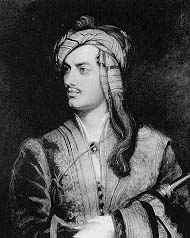
Thomas Phillips. Lord Byron
in Albanian Costume. 1814. from Arts and Ideas William
Fleming, 9th ed: p. 532
|
"She Walks in Beauty"
E-Text
Questions for Group Discussion and Journal
1. What are the similes and images used to describe this lady?
2. How is the lady characterized? How do the sound effects
(e.g. open vowels, "r" "l" and "m" sounds) help convey the meanings?
3. Does the fact that the actual lady is
in mourning and is Byron's cousin affect your picture of her?
Application & Wild Association
1. Can you picture a woman like the one in this
poem? In your imagination, is she seen in slow motion, with soft-focus?
And with what background music?
2. This poem, as well as some sonnets and courtly
love poetry you are going to read, has woman as the object of the poets'
love, adoration and idealistic description. How is this woman different
from the women characters you have read so far (e.g. Lady Bracknell, Gwendolen
and Cecily in The Importance of Being Earnest, Emily in "A Rose
for Emily," etc.)?
Byron
: Relevant Links
Romanticism:
Relevant Links
 General Introduction
General Introduction
Romanticism--A
brief statement about Romanticism from WebMuseum, Paris (in both English
and French).
English
Romantic Poets - The Site biography, work and other information
of the six male Romantic poets and Gerald Manley Hopkins .
The
Romantic Chronology
Romantic
Passions: Cultural Product or Universal Feelings including
views and texts on Romantic love since the nineteenth century.
 Further Studies
Further Studies
-
Romantic
Circles: a Website devoted
to the study of Lord Byron, Mary Wollstonecraft Shelley, Percy Bysshe Shelley,
John Keats, their contemporaries and historical contexts. Romantic Circles
is the collaborative product of editors, contributors, and users around
the world--a wide community with a shared interest in the literature and
culture of the younger Romantics and their ever-widening circles of influence.
-
Voice
of the Shuttle--Romantics
-
FAVORITE
ROMANTICISM LINKS
 E-Text
Archive
Wordsworth's
Complete Works (1888)
The
William Blake Archive
Shelley:
Complete Poetical Works (1901)
E-Text
Archive
Wordsworth's
Complete Works (1888)
The
William Blake Archive
Shelley:
Complete Poetical Works (1901)
back to the top
Internet-Assisted
Course page




